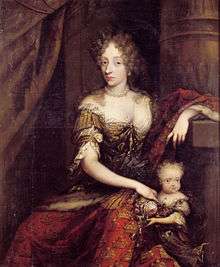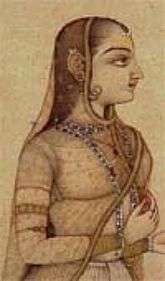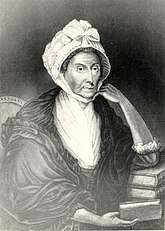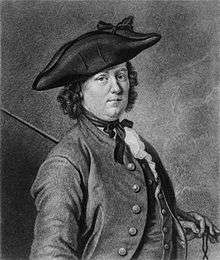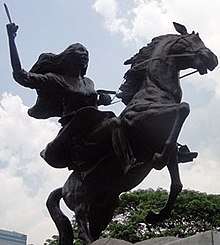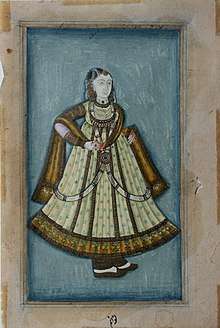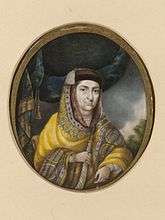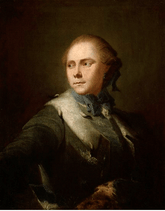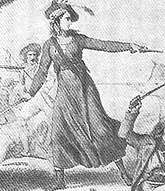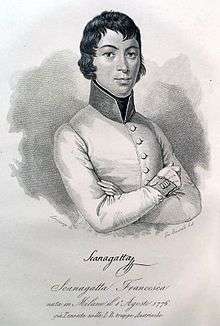Women in 18th-century warfare
Active warfare throughout recorded history has predominantly involved male combatants; however, women have also contributed to military activities including as combatants. The following list describes women known to have participated in military actions in the 18th century. For women in warfare in the United States at this time, please see Timeline of women in war in the United States, Pre-1945.
Timeline of women in warfare from 18th century warfare worldwide (except the present US)
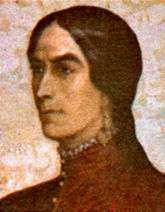
Micaela Bastidas Puyucahua
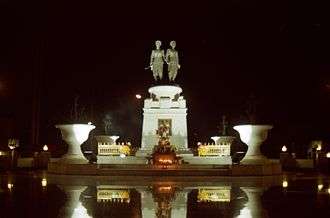
Thao Thep Kasattri and Thao Sri Sunthon
18th century
- 1700–1721: An unnamed woman serves in the Swedish army in the Great Northern War; after the war, she is seen wearing men's clothing on the streets of Stockholm until the 1740s, where she was known as "The Rider".[1]
- 1700s: Mary Read serves as a soldier before becoming a pirate.[2]
- 1700s: Margareta von Ascheberg acting colonel of her dead husband's regiment during the Great Northern War.[3]
- 1700: During the Battle of Narva, Swedish forces manage to capture some of the Russian soldiers besieging Narva, and discover them to be women dressed as males.[4]
- 1700: Charlotte Amalie of Hesse-Cassel organize the defense of Copenhagen against invasion.[5]
- 1700–1709: Tarabai, a queen of the Maratha empire in India, leads a war against invading Mughals.[6]
- 1700–1712: Maria Ursula d'Abreu e Lencastro fights in the Portuguese army in India.[7]
- 1702: Anna Isabella Gonzaga, Duchess of Mantua, defends Mantua during the War of the Spanish succession as regent during the absence of her spouse.[8]
- 1702: Marij Jacobs Weijers serves in the Dutch army dressed as a male.[9]
- 1705: Mai Bhago leads Sikh soldiers against the Mughals.[10]
- 1705–1708: Catharina Margaretha Linck serves as a soldier in the armies of Hanover, Prussia, Hesse, and Poland.[11]
- 1705: Grietje Harmense Knipsaar serves in the Dutch army dressed as a male under the name Dirk Jansen.[9]
- 1706: Gertruid ter Brugge serves in the Dutch dragoons and is afterward a local celebrity known as "La Dragonne".[12]
- 1709–10: The Hungarian noblewoman Géczy Julianna defends Lőcse against the Habsburg forces during the rebellion of Francis II Rákóczi.[13]
1710s
- 1710s: During the Great Northern War, Maria Faxell, the wife of a vicar, defends her village against a Norwegian attack by handing out old weapons to both men and women during her husband's absence.[14]
- 1711–1721: Ingela Gathenhielm operates the Swedish Privateering fleet jointly with her husband during the Great Northern War; when widowed in 1718, she continues herself.[15]
- 1712–1714: Anna Jöransdotter from Finland serves in the Swedish army under the named Johan Haritu.[16]
- 1712–1717: Three unnamed females are discovered to have served in the Dutch Marines dressed as males.[9]
- 1713–1721: Margareta Elisabeth Roos is said to have served in the Swedish army.[17]
- 1713–1726: Ulrika Eleonora Stålhammar serves in the Swedish army under Charles XII of Sweden during the Great Northern War.[16]
- 1713–1714: Annika Svahn, as well as several other enslaved Finnish women taken captive by the Russians, are forced to participate in the Russian conquest of Swedish Finland on the battle fields during the Greater Wrath dressed in Russian dragoon uniforms.[18]
- 1715: Two unnamed women are rumored to have served among the soldiers in the Swedish army, one of them a wife of one of the soldiers, who by this point was to have served for a period of four years.[16]
- 1715-1718: Anna Maria Christmann serve dressed as a man in the Austrian army under Prince Eugene of Savoy during the Ottoman–Venetian War (1714–1718).[19]
- 1716: Norwegian Anna Colbjørnsdatter is granted the success in the victory over the Swedes at the Battle of Norderhov in Norway during the Great Northern War 29 March 1716 by capturing 600 Swedish soldiers.[20]
- 1716: Norwegian Kari Hiran averts the Swedish attempt to conquer Norway by feeding them false information about the size of the Norwegian army.[21]
- 1716–1718: Hangbe in the Kingdom of Dahomey becomes the regent after her twin brother Akaba is killed. She may have led military campaigns.[22]
- 1719: Brita Olsdotter, an old Swedish woman, meets the Russian army, who marches against Linköping after having burnt Norrköping, and makes them turn around and leave after telling them that reinforcements were arriving to assist Linköping.[23]
1720s
- 1720–1739: Granny Nanny, a spiritual leader of the Maroons of Jamaica, leads rebel slaves in First Maroon War against the British.[24]
- 1721: Comtesse de Polignac, previously the lover of Duc de Richelieu, fights a duel with her rival and successor, the Marchioness de Nesle.[25]
- 1722: Six unnamed females are shipped back to the Netherlands after having been exposed to have served as males in either the Dutch Marines or army in an attempt to emigrate to the Dutch East Indies.[9]
- 1723: Lumke Thoole serve in the Dutch navy dressed as a male under the name Jan Theunisz.[9]
- 1725: Dutch woman Maria ter Meetelen serves in the Spanish army dressed as a man.[26]
- 1726: Maria Elisabeth Meening served in the Dutch navy dressed as a male.[9]
1730s
- 1732: An unnamed female serve in the Dutch army dressed as a male.[9]
- 1738–1752: Johanna Sophia Kettner serve in the imperial Austrian infantry for fourteen years in the guise of a man and is promoted to feldwebel.[27]
1740s
- 1740: Ann Mills fights on the frigate Maidenstone as a dragoon.[28]
- 1741–1743: Maria van de Gijessen served in the Dutch navy under then name Claes van de Gijessen.[29]
- 1744: An unnamed female serve in the Dutch navy dressed as a male.[9]
- 1745: Jacobina (last name unknown) served in the Dutch navy dressed as a male.[9]
- 1745: An unnamed female served in the Dutch navy dressed as a male.[9]
- 1745: Phoebe Hessel fights in the Battle of Fontenoy. She had disguised herself as a man to do so.[30]
- 1745: Scottish Mary Ralphson fights in the British army in Battle of Fontenoy dressed as a man[31]
- 1746: Johanna Bennius serve in the Dutch navy dressed as a male under the name Jan Drop.[9]
- 1746: Elisabeth Huyser serve in the Dutch army dressed as a male.[9]
- 1746–1769: Maria van Antwerpen serves as a soldier in the Netherlands under the name Jan van Art.[32]
- 1748: Gertruid van Duiren enlists and briefly serve in the Dutch army before being discovered[33]
- 1747–1750: Hannah Snell, serve disguised as a man in the Royal Marine: her military service is officially recognized in 1750, and she is granted a pension.[34]
1750s
- 1750: Maria Sophia Stording serve in the Dutch navy dressed as a man.[9]
- 1751: Two unnamed soldiers of the Dutch navy are discovered to be females dressed as males.[9]
- 1754: An unnamed female serve in the Dutch army dressed as a man.[9]
- 1755: An unnamed female serve in the Dutch navy dressed as a man.[9]
- 1756: Soldier Jochem Wiesse of the Dutch army are discovered to be a female dressed as a male.[9]
- 1757: Sailor "Arthur Douglas" is revealed to be a woman. Her birth-name is unknown.[35]
- 1757: An unnamed female serve in the Dutch army dressed as a man.[9]
- 1757–58: Two unnamed females serve in the Dutch navy dressed as a males.[9]
- 1759–1771: Mary Lacy serves as a Marine carpenter under the name of "William Chandler".[36]
1760s
- 1760s: Petronella van den Kerkhof possibly serve in the Dutch army as a grenadier: however, as she was not discovered during service, this is unconfirmed.[37]
- 1760: Petronella van der Kerkhof serve in the Dutch grenadiers dressed as a male.[9]
- 1760–1761: A woman serves in the British Marines as "William Prothero".[35]
- 1762: Rafaela Herrera inspires the outnumbered Spanish defenders to victory during a 1762 British siege of the Fortress of the Immaculate Conception in El Castillo village within El Castillo municipality, Nicaragua.[38]
- 1763: After the assassination of her husband Diego, Filipina Gabriela Silang decided to continue his rebellion in Ilocos against Spain but was unsuccessful.[39]
- 1764: The Dutch soldier Tiesheld is discovered to be a female dressed as a male.[9]
- 1765: A unnamed member of the Dutch navy is discovered to be a female dressed as a male.[9]
- 1768: Birth of Mah Laqa Bai. Due to her archery skills, she accompanied the Nizam II (Mir Nizam Ali Khan) in three wars;[40]
- 1769: Anna Sophia Spiesen serve in the Dutch army dressed as a male under the name Claas Paulusse.[9]
1770s
- 1770–1771: Margareta Reymers serve in the Dutch navy dressed as a man: she is discovered by her pregnancy.[41]
- 1772: Mademoiselle de Guignes and Mademoiselle d'Aguillon fight a duel in Paris.[42]
- 1775: On Dec. 11, Jemima Warner was killed by an enemy bullet during the siege of Quebec. Mrs. Warner had originally accompanied her husband, PVT James Warner of Thompson's Pennsylvania Rifle Battalion, to Canada because she feared that he would become sick on the campaign trail and she wanted to nurse him. When PVT Warner eventually died in the wilderness en route to Quebec, Mrs. Warner buried him and stayed with the battalion as a cook.[43]
- 1778: Baltazara Chuiza leads a rebellion against the Spanish in Ecuador.[44]
- 1778: Sikh princess Bibi Rajindar Kaur leads 3,000 soldiers to rescue her cousin who was defeated by Hari Singh.[45]
- 1778–1803: The ruling Princess of Sardhana, Begum Samru (Johanna Noblis), leads her armies in war.[46]
1780s
- 1780: Rani Velu Nachiar of Sivagangai Poligar leads a female army against the British in India.[47]
- 1780: Manuela Beltrán organizes a peasant revolt in Colombia.[48]
- 1780: Ñusta Huillac of the Kolla tribe rebels against the Spanish in Chile.[49]
- 1780s: Swedish runaway Carin du Rietz becomes a soldier at the royal guard.[50]
- 1780–1781: Micaela Bastidas Puyucahua recruits and leads men and women in battle during a rebellion against the Spanish rule in Peru. She is eventually captured and executed by the Spanish.[51]
- 1780–1781: Maria van Spanje serve in the Dutch navy for eight months dressed as a male: she is discovered while trying to repeat this when enlisting anew in 1782.[52]
- 1781: Lena Catharina Wasmoet serve in the Dutch navy dressed as a man under the name Claas Waal.[9]
- 1781: Gregoria Apaza, an Aymara woman, leads an uprising against the Spanish in Bolivia.[53]
- 1781: Margaret Thompson serves in the British Marines under the name George Thompson.[54]
- 1782: Anna Maria Everts serve in the Dutch navy dressed as a man.[9]
- 1782: Bartolina Sisa, an Aymara woman who led an indigenous uprising against the Spanish in Bolivia, is captured and executed.[55]
- 1783: Johanna Dorothea Heeght serve in the Dutch navy dressed as a man under the name Johannes Hegt.[9]
- 1785: According to Thai legend, Thao Thep Kasattri and Thao Sri Sunthon, two sisters, help repel a Burmese invasion of Thailand by dressing as male soldiers and rallying the troops.[56][57][58][59][60]
- 1787–1807: A woman serves twenty years in the British Marines under the name "Tom Bowling"[35]
- 1787: The wife of the German colonel Schutz is reported to have accompanied her spouse dressed as a male in warfare and having been wounded two times in Russian service.[61]
- 1788–1790: After the war between Russia and Sweden, several of the soldiers decorated in the Swedish army are discovered to be women in disguise. One of them is Brita Hagberg, who enlisted in search of her husband; she is given a military pension.[62]
- 1788–1790: During the Russo-Swedish war, Anna Maria Engsten, after a battle at sea, singlehandedly steers one of the boats back to Sweden after having been left alone onboard after its evacuation; she is decorated for bravery at sea.[63]
- 1788–1790: During the Battle of Svensksund, Dorothea Maria Lösch takes command of a Swedish ship and is rewarded with the rank of captain of the Swedish fleet.[64]
1790s
- 1791-1813: Bulgarian heroine Sirma Voyevoda fight in the Bulgarian guerilla army against Ottoman oppression.[65]
- 1792: Reine Audu participates in the fight with the Swiss guards in the storming of the Tuileries Palace.[66]
- 1792: The Greek woman Moscho Tzavela leads several women in defense of their village against the Turks.[67]
- 1792–1793: The sisters Félicité de Fernig and Théophile de Fernig, known as Sœurs Fernig serve in the French army during the Battle of Valmy, Battle of Jemappes, Battle of Anderlecht, and the Battle of Nerwinde.[68]
- 1792: Mary Anne Talbot may have served as a soldier and sailor in the British army during the French revolutionary wars.[69]
- 1792: Lady Braddock and Mrs. Elphinstone fight a duel in England.[70]
- 1792–1808: Marie-Jeanne Schellinck serve in French army. She participates in the Battle of Jemappes.[71]
- 1792–1799: Angélique Brûlon serves in the French army in Corsica.[72]
- 1793: Suzanne Bélair, called Sanité Bélair, serve in the armé of Toussaint Louverture during the Haitian Revolution. She was promoted to sergeant, and was executed by the French in 1802.[73]
- 1790s: Victoria Montou serves in the army of Jean-Jacques Dessalines during the Haitian Revolution.[74]
- 1793: Renée Bordereau disguises herself as a man and fights as a Royalist cavalier in the French Revolution.[75]
- 1793: Françoise Deprés serve as a royalist spy, courier and soldier dressed as a male during the Vendée rebellion.[9]
- 1793: Céleste Bulkeley serve in the Catholic and Royal Army during the war in the Vendée as one of at least six women known as the amazons in the army of François de Charette.[76]
- 1793–1800: Marie-Thérèse Figueur serve openly in the French army.[77]
- 1793: An unnamed female serve in the Dutch navy dressed as a man.[9]
- 1796: Sikh princess Bibi Sahib Kaur leads armies into battle against the British. [78]
- 1796–1798: Wang Cong'er is the leader and commander of the White Lotus rebellion in China.[79]
- 1797: Rebel Wang Nangxian commands a rebel army against the Imperial forces during the White Lotus Rebellion.[79]
- 1797: Jemima Nicholas single-handedly took 12 French soldiers capture armed with only a pitchfork during the Battle of Fishguard (commonly known as the last invasion of Britain). [80]
- 1797–1801: Franziska Scanagatta serve in the Austrian army: she is promoted a lieutenant in 1800.[81]
- 1798: Mary Ann Riley and Anne Hopping serve in the British Marines during the Battle of the Nile against the French outside Egypt.[82]
- 1798: Mary Doyle, an Irish woman, participates in the Irish rebellion against the British.[83]
- 1798: Betsy Gray fought in the Battle of Ballynahinch against the Yeomanry.[84]
- 1798–1815: Veronika Gut organize the resistance rebel movement against the French occupation of the Helvetic Republic in the Swiss canton of Nidwalden.[85]
- 1799: The German Antoinette Berg serve on the side of the English against the French in the Netherlands dressed as a male; during the peace festivities in London after the final defeat of Napoleon in 1814, she was presented to the Tsar of Russia and the King of Prussia.[9]
gollark: > actually localising your code
gollark: My web ones, thæt is.
gollark: In web ones, it's logged and also has a partial description sent as the response.
gollark: My applications are programmed to just display the error because nobody except me uses them.
gollark: In any case, I do *not* want stuff to silently break without telling me, nor do I want to manually type `if err != nil { return err }` after every line.
References
- 208 (Anteckningar om svenska qvinnor)
- Mary Read and Anne Bonny By Rebecca Stefoff p. 20
- Margaretha Ascheberg, von, urn:sbl:18867, Svenskt biografiskt lexikon (art av Gunnar Carlquist.), hämtad 2014-12-28.
- Norrhem, Svante, Christina och Carl Piper: en biografi [Christina and Carl Piper: a biography], Historiska media, Lund, 2010 (Swedish)
- Dansk Biografisk Leksikon
- Eaton, Richard M. (2005). A Social History of the Deccan, 1300–1761: Eight Indian Lives, Volume 1. Cambridge, England: Cambridge University Press. pp. 177–203. ISBN 0-521-25484-1.
- MACEDO, Joaquim Manuel de. Anno biographico brazileiro (v. 1). Rio de Janeiro, Typographia e Litographia do Imperial Instituto Artístico, 1876.
- Enciclopedia Italiana (1929)
- Rudolf Dekker en Lotte van de Pol, Vrouwen in mannenkleren. De geschiedenis van een tegendraadse traditie. Europa 1500–1800 (Amsterdam 1989)
- Smith, Bonnie (2008). The Oxford Encyclopedia of Women in World History, Volume 1. Oxford University Press. p. 226. ISBN 9780195148909.
- Angela Steidele, In Männerkleidern. Das verwegene Leben der Catharina Margaretha Linck, hingerichtet 1721, Cologne: Böhlau, 2004., ISBN 3-412-16703-7.
- Brugge, Geertruid ter (?-na 1706)
- Förster Rezső: A lőcsei fehér asszony történeti alakja. Bp., 1933 (A Kis Akadémia Könyvtára, V. köt.)
- 134 (Anteckningar om svenska qvinnor)
- Harrison, Dick (2007). "Kvinnorna som blev pirater: två kvinnliga sjörövare står fram i vår historia : kaparredaren Ingela Gatenhielm och piratdrottningen Johanna Hård : båda visade att brott kan löna sig!". Svenska turistföreningens årsbok "2007,": sid. 24–35. 0283-2976.
- Borgström Eva, ed (2002). Makalösa kvinnor: könsöverskridare i myt och verklighet (Marvelous Women: genderbenders in myth and reality) Stockholm: Alfabeta/Anamma. Libris 8707902. ISBN 91-501-0191-9 (inb.)(Swedish)
- Borgström Eva, ed (2002). Makalösa kvinnor: könsöverskridare i myt och verklighet (Marvelous Women: genderbenders in myth and reality) Stockholm: Alfabeta/Anamma. Libris 8707902. ISBN 91-501-0191-9 (inb.)
- Suomen kansallisbiografia (National Biography of Finland)
- Helmut Engisch: Eine Jungfrau im Türkenkrieg: Wie die Anna Maria Christmann als württembergischer Grenadier das Abendland retten half und dann in Stuttgart Briefträgerin wurde. In: Helmut Engisch: Ein Mönch fliegt übers Schwabenland. Theiss, Stuttgart 1996, ISBN 3-8062-1270-8
- Hans Colbjørnsen (Store norske leksikon)
- Norheim, Olav: «Den modige finnekjærringa», Terra Buskerud. Historieboka.no
- Bay, Edna (1998). Wives of the Leopard: Gender, Politics, and Culture in the Kingdom of Dahomey. University of Virginia Press.
- 291 (Anteckningar om svenska qvinnor)
- Government of Jamaica, national heroes listing
- Lewis G. M. Thorpe: Nottingham French Studies, V. 41. W. Heffer., 2002.
- Digitaal Vrouwenlexicon van Nederland (DVN)
- Günther Noé, "Amazonen" in der österreichischen Geschichte. – In: Österreich in Geschichte und Literatur, Band 30 (1986), S. 350–361
- Felsenstien, Frank: Unraveling Ann Mills. Some thoughts on Gender Construction and Naval Heroism (2006)
- Gijssen, Maria van de (1720?-na 1743)
- The Circulator of useful knowledge, amusement, literature, science and general information. London, 1825 p.147
- Isabelle Bauino, Jacques Carré, Cécile Révauger: The Invisible Woman: Aspects Of Women's Work In Eighteenth-century Britain. Retrieved 6 October 2014.
- FTM Contributions in HIStory
- Duiren, Geertruit van (?-na 1748)
- Matthew Stephens – Hannah Snell: The Secret Life of a Female Marine, 1723–1792
- Suzanne J. Stark: Female tars: women aboard ship in the age of sail. Naval Institute Press, 1996
- The Lady Tars: The Autobiographies of Hannah Snell, Mary Lacy and Mary Anne Talbot. Retrieved 6 October 2014.
- Kerkhof, Petronella van de (ca. 1741–1818)
- Carlos Viscasillas (2009). "La Fortaleza de la Inmaculada Concepción de María" (in Spanish). Managua, Nicaragua: Agencia Española de Cooperación Internacional para el Desarrollo (AECID). Retrieved 2011-04-24.
- Commire, Anne, and Deborah Klezmer. Women in World History: A Biographical Encyclopedia. Waterford, Connecticut: Yorkin Publications, 2002. Print.
- Rajendra, Rajani (19 April 2013). "Glimpse into Mah Laqa's life". The Hindu. Retrieved 23 May 2013.
- Reymers, Margareta (ca. 1747-na 1771)
- Florence Marryat: Her Father's Name
- Women In Military Service For America Memorial
- Uglow, Jennifer; Maggy Hendry (1999). Frances Hinton (ed.). The Northeastern Dictionary of Women's Biography. UPNE. p. 75. ISBN 978-1-55553-421-9.
- Encyclopaedia of women biography: India, Pakistan, Bangladesh, Volume 3 Nagendra Kr Singh A.P.H. Pub. Corp., 2001 - Social Science
- Chisholm, Hugh, ed. (1911). . Encyclopædia Britannica. 24 (11th ed.). Cambridge University Press. p. 210..
- The Hindu – 10-Aug-2010
- Phelan, John Leddy: "El pueblo y el rey. La revolución comunera en Colombia, 1781". Bogotá: Carlos Valencia.
- Ethnic Groups of the Americas: An Encyclopedia By James Minahan 2013 p. 213
- Jakob Christensson: Signums svenska kulturhistoria. Gustavianska tiden. (2007)
- Uglow, Jennifer; Maggy Hendry (1999). Frances Hinton, ed. The Northeastern Dictionary of Women's Biography. UPNE. p. 75. ISBN 978-1-55553-421-9.
- Spanje, Maria van (1759?-na 1782)
- del Valle de Siles, María Eugenia (1981). Bartolina Sisa y Gregoria Apaza: dos heroínas indígenas. Biblioteca Popular Boliviana de "Última Hora". p. 73.
- How to Survive in the Georgian Navy: A Sailor's Guide By Bruno Pappalardo
- Hylton, Forrest (2007). Revolutionary horizons: Popular struggle in Bolivia. London: Verso. ISBN 978-1-84467-070-3.
- "Changing Identities Among the Baba Chinese and Thai Muslims in a Tourist Paradise, Khoo Su Nin (Salma) Nasution" (PDF). Archived from the original (PDF) on 2011-09-04. Retrieved 2010-07-08.
- Phuket history by Richard Russell MD
- phuket history Gotophuket.com
- Thao Thep Krasatri and Thao Sri Soonthorn
- Thalang's defiant last stand Tipwarintron Tanaakarachod
- Potemkin: Catherine the Great's Imperial Partner, 2005 (Swedish edition), p 445
- Christer Johansson: Soldathustrur, markenteskor och kvinnliga krigare
- 130 (Anteckningar om svenska qvinnor)
- 250 (Anteckningar om svenska qvinnor)
- .Македонска енциклопедија, том 2, МАНУ, Скопие, 2009, стр. 1364.
- Marc de Villiers, Les 5 et 6 octobre 1789. Reine Audu les légendes des journées d'octobre, 1917.
- Dever, John P.; Dever, Maria C. (1995). "Moscho Tzavella". Women and the Military: Over 100 Notable Contributors, Historic to Contemporary. Jefferson, N.C.: McFarland & Co. p. 142. ISBN 978-0-89950-976-1.
- « Sœurs Fernig », dans Charles Mullié, Biographie des célébrités militaires des armées de terre et de mer de 1789 à 1850, 1852
- Oxford Dictionary of National Biography, Volume 53. Oxford University Press. 2004. p. 709. ISBN 0-19-861403-9.Article by Julie Wheelwright.
- Robert Baldick: The Duel: A History of Duelling
- Les militaires qui ont changés la France, sous la direction de Fabrice Fanet et Jean-Christophe Romer ; avec la collaboration de Thierry Widemann. Paris, le Cherche-Midi, DL 2008 (p. 472) (notice BnF no FRBNF41279187r)
- Jean-Loup Avril 1000 Bretons: dictionnaire biographique- 2002 – Page 133 "Marie-Angélique Duchemin quitte l'armée, puis est admise à l'Hôtel des Invalides où elle passera 61 ans. ... Ce ne sera que par décret du 15 août 1851 à l'occasion de la fête impériale que Marie-Angélique Duchemin, veuve Brulon, figurera ..."
- Jomini, Antoine-Henri. (1842). Histoire critique et militaire des guerres de la Révolution
- Jean-Baptiste Mirambeau, Victoria, dans Le Document, no.2, Février 1940, p107.
- Marilyn Yalom, Blood Sisters: The French Revolution in Women's Memory, Basic Books, 1993, p. 201.
- L'histoire tragique de Céleste Bulkeley est racontée dans « Un Vendéen sous la Terreur », d'après le manuscrit de son frère Toussaint Ambroise Talour de la Cartrie ; ce manuscrit, aujourd'hui perdu, a d'abord été édité en anglais puis re-traduit en français par Pierre Amédée Pichot (édition de 1910 et fac-similé de 1988).
- Gabriel Dumay, Thérèse Figueur, dite Madame Sans-Gêne, dragon aux 15e et 93 régiments (1793–1815) (1904), with subsequent additions in "Extrait des procès-verbaux du séances", Mémoires de l'Académie des Sciences, Arts et Belles-Lettres de Dijon, 4th Series, vol. 11 (1910), pp. xxxii–xxxiv, lviii–lx; Léon Hennet, "Femmes Soldats dans les armees de la révolution", La Nouvelle Revue Français 40 (1919), pp. 341–353 at pp. 347–48; Philippe Lefrancois, "La vraie Madame Sans-Gêne, dragon et blanchisseuse", Miroir de l'histoire 98 (1958), pp. 233–236.
- https://www.allaboutsikhs.com/great-sikh-women/bibi-sahib-kaur
- Lily Xiao Hong Lee, Clara Lau, A.D. Stefanowska: Biographical Dictionary of Chinese Women: v. 1: The Qing Period, 1644–1911
- "Invasion heroine's records find". BBC News. 4 April 2006. Retrieved 10 May 2017.
- Nikolaus Reisinger: Frauen und Militär in der Neuzeit: Francesca Scanagatta – Die militärische Karriere einer Frau im ausgehenden 18. Jahrhundert. In: Das achtzehnte Jahrhundert und Österreich. (= Jahrbuch der Österr. Gesellschaft zur Erforschung des 18. Jahrhunderts. 16/2001). Wien 2001, S. 59–73.
- Beth Hill,Cathy Converse: The Remarkable World of Frances Barkley: 1769–1845
- Women and War: A Historical Encyclopedia from Antiquity to the Present. Bernard A. Cook. Retrieved 6 October 2014.
- Bartlett/Dawson/Keough: Thomas Bartlett, Kevin Dawson, Daire Keogh, The 1798 Rebellion: An Illustrated History, Roberts Rinehart, 1998, p.172
- Franz Joseph Gut: Der Überfall in Nidwalden im Jahr 1798 in seinen Ursachen und Folgen. Stans 1862; Neuauflage Kägiswil 1989.
Further reading
- Cook, Bernard, ed. Women and War: Historical Encyclopedia from Antiquity to the Present (2006).
- Elshtain, Jean Bethke. Women and War (1995)
- Elshtain Jean, and Sheila Tobias, eds. Women, Militarism, and War (1990)
- Mayer, Holly A. Belonging to the Army: Camp Followers and Community during the American Revolution (University of South Carolina Press, 1996)
- Jones, David. Women Warriors: A History (Brassey's, 1997)
- Martino-Trutor, Gina Michelle. "Her Extraordinary Sufferings and Services": Women and War in New England and New France, 1630–1763" PhD Dissertation, U of Minnesota, 2012. online
- Pennington, Reina. Amazons to Fighter Pilots: A Biographical Dictionary of Military Women (2003).
External links
| Wikimedia Commons has media related to Women in the military. |
This article is issued from Wikipedia. The text is licensed under Creative Commons - Attribution - Sharealike. Additional terms may apply for the media files.

